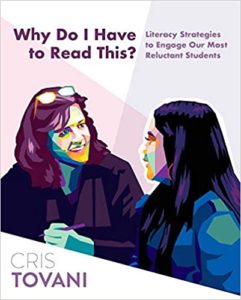Help Kids Stop Hiding Behind Literacy Masks
Why Do I Have to Read This? Literacy Strategies to Engage Our Most Reluctant Students
By Cris Tovani
(Stenhouse Publishers, 2021 – Learn more)
Reviewed by Linda Biondi

All sorts of stories would go through our minds, perhaps none of them correct. Now wearing a mask in public is commonplace (often mandatory) . The only time we pay attention to the person wearing the mask is if they are wearing it incorrectly or we happen to like the logo on it.

Her latest book, Why Do I Have to Read This? Literacy Strategies to Engage Our Most Reluctant Students, provides insight into the various imaginary “literacy masks” that students wear.
Deciphering the meaning of students’ masks
These masks often make students appear disinterested, angry, sullen, or sarcastic, acting as the resident comedian in the classroom. Throughout the book, you will meet tweens and teens who might remind you of a student in your class or perhaps yourself as a student.
Tovani guides the reader to help us understand these disguises students often wear, why they wear them, and how we can work with our students to shed them.
- Masks of Anger and Apathy
- Mask of the Class Clown
- Mask of Minimal Effort
- Mask of Invisibility
Tovani begins her book by introducing Ugo. Ugo is one of those students you might hear about in the faculty room. The kid that just doesn’t want to do anything. “The Tough Kid.” This student might wear a mask of defiance and anger when meeting with teachers. In Ugo’s case, the “mask of defiance” worked to hide his fear of failure from his teachers.
Then there’s the kid who comes into the classroom and seems to disrupt everything by their demeanor. Perhaps giggling or laughing at nothing in particular or purposely burping loud enough so the entire class can hear. That’s the “Mask of the Class Clown” avoiding the lesson, being afraid of failure or showing lack of confidence.
Then we have that kid who feels like the work is always boring, doesn’t care, does the least amount of work possible. That student is wearing the “Mask of Minimal Effort.” This student is always finished first, doesn’t see any need to reread, revise or edit, and sometimes feels that the additional effort isn’t needed because he/she always gets an “A’ anyway. “Why try when you are already the best in the class?”
Lastly is the student who blends into the woodwork, more or less. They are compliant, do their work, are often well organized. They wear the “Mask of Invisibility.” They might be deep thinkers, challenge our own ideas, even have the potential for leadership, but they are so quiet we don’t notice any of their qualities.
Drawing students from behind their masks
I appreciate Tovani’s honesty and candor throughout the book as she shares stories about her own self discovery as a literacy teacher and coach. We gain an insight into her educator’s mind and inner thoughts – especially how a “unsolicited coaching letter” from a critical friend changed her as a teacher. We learn first hand how she developed her CYA Structures that harness the power of the 6 Ts: Topic, Tasks, Targets, Text, Tend to Me, and Time.
In Chapter Two, she introduces CYA (Curriculum You Anticipate) in depth – structures that help you plan long term units and set daily goals so that student work is connected and students feel the connection. Chapters 3-6 center around learners who wear various masks and ways to implement strategies and structures to assist you reach them. By the time you reach chapter seven, you will feel more confident and powerful as an educator!
I am a reader. I was always a reader, even as a child, but I was a reader of fiction. Reading nonfiction was a struggle, even when reading about something that was of interest to me. My mind would wander, or I’d find an excuse to do something else or start skimming the “good parts.”
As I read this book, I felt myself slowing down and absorbing every word, and thought of the expression, “Where have you been all my life?” I found Tovani’s nonfiction text compelling. I wanted to turn each page and learn more about her students. I wanted to learn how I – now a teacher educator – can help other teachers inspire their students to want to read. I couldn’t wait to read the next page, let alone the next chapter. She “hooked” me in as a reluctant nonfiction reader!
✻✻ Read a recent MiddleWeb article by Cris Tovani ✻✻
This book is not just for ELA and reading teachers but for all teachers. Imagine trying to get students excited about the rock cycle in middle school – trying to find texts that will motivate students to read, research, and relate.
Cris Tovani was faced with that predicament in the middle of facilitating a demo lesson with students (with science teachers watching) and being grilled by Rodderick (the class clown), who asks the dreaded question: “Why do we have to read this?” It took some quick thinking, but she was able to excite students by showing them the relevance and using her strategies to make connections with them.
Strategies that work across content areas
Inside this book you will find literacy strategies for all content areas that will engage and empower students to become excited about the curriculum, reading, and learning. In the appendix are reference charts for various curriculum areas:
- Learning Target Rubrics
- Double-Entry Diaries
- Inner Voice Sheets
- Synthesis Sheets
- Vocabulary Builder
- Silent Reading Response Sheet
- Virtual Background Knowledge Placemats
As a supervisor of student teachers, I am always looking for books to recommend to my students. This is an excellent text for all teachers. The strategies are explained clearly with examples, anecdotes, and charts which provide additional support. The strategies are student centered and reflect best practices in the subject areas.
I have to admit I am a big Tovani fan and used her resources in my own classroom for many years. Cris Tovani “gets” kids and “gets” teachers. She knows their struggles, hopes and dreams. This book certainly makes the “Top Ten List” of books to have and use in these challenging times.
After teaching fourth and fifth graders for 41 years, Linda Biondi is supervising preservice and student teachers at The College of New Jersey and Rider University. She has co-facilitated summer writing institutes in conjunction with the National Writing Project and volunteers for two service organizations: Homefront and Dress for Success of Central New Jersey – with missions to end homelessness and empower women to achieve through economic independence.































Thanks for the recommendation!